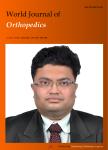Hallux rigidus: How do I approach it?
Hallux rigidus: How do I approach it?作者机构:Albert Einstein College of Medicine Leni and Peter W. May De-partment of Orthopaedic Surgery Icahn School of Medicine at Mount Sinai Department of Orthopedics University of Insubria
出 版 物:《World Journal of Orthopedics》 (世界骨科杂志(英文版))
年 卷 期:2017年第8卷第5期
页 面:364-371页
学科分类:1002[医学-临床医学] 100210[医学-外科学(含:普外、骨外、泌尿外、胸心外、神外、整形、烧伤、野战外)] 10[医学]
主 题:Hallux rigidus Cheilectomy Arthrodiastasis Moberg osteotomy Arthodesis Interpositional arthroplasty Arthroplasty
摘 要:Hallux rigidus is a degenerative disease of the first metatarsalphalangeal(MTP) joint and affects 2.5% of people over age 50. Dorsal osteophytes and narrowed joint space leads to debilitating pain and limited range of motion. Altered gait mechanics often ensued as 119% of the body force transmit through the 1^(st) MTP joint during gait cycle. Precise etiology remains under debate with trauma being often cited in the literature. Hallux valgus interphalangeus, female gender, inflammatory and metabolic conditions have all been identified as associative factors. Clinical symptoms, physical exam and radiographic evidence are important in assessing and grading the disease. Non-operative managements including nonsteroidal antiinflammatory drugs, intraarticular injections, shoe modification, activity modification and physical therapy, should always be attempted for all hallux rigidus patients. The goal of surgery is to relieve pain, maintain stability of the first MTP joint, and improve function and quality of life. Operative treatments can be divided into joint-sparing vs joint-sacrificing. Cheilectomy and moberg osteotomy are examples of joint-sparing techniques that have demonstrated great success in early stages of hallux rigidus. Arthrodesis is a joint-sacrificing procedure that has been the gold standard for advanced hallux rigidus. Other newer procedures such as implant arthroplasty, interpositional arthroplasty and arthroscopy, have demonstrated promising early patient outcomes. However, future studies are still needed to validate its long-term efficacy and safety. The choice of procedure should be based on the condition of the joint, patient s goal and expectations, and surgeon s experience with the technique.



